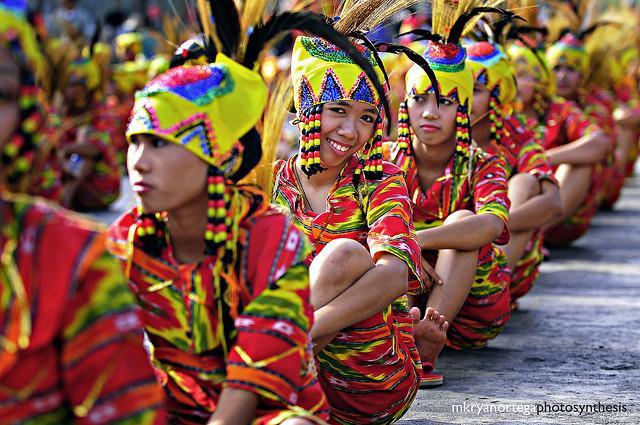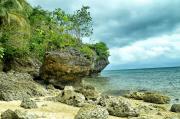
Araw ng Dabaw - Every March16
“Araw ng Dabaw” is a vibrant feast, a celebration of the Davaoenos’ oneness, observed with a grand parade along the major thoroughfares of the city’s the Mutya ng Dabaw, the city’s Ambassadress of Goodwill. Various arts, cultural, musical, culinary, sports, and street events are held during the celebration.

Indigenous people (Lumad) - 75th Araw ng Davao 2012 Parade Roxas Boulevard, Davao City - Philippines
Kadayawan Festival - Every 3rd week of August
Davao comes alive with the celebration of the “Kadayawan sa Dabaw”. The Kadayawan is a celebration of life, a thanksgiving for the gifts of nature, the wealth of culture and history, the bounties of harvest, and serenity of living. The festival pays tribute to Davao’s artistic, cultural and historical heritage. Exciting events include the search for the “Hiyas sa Kadayawan”. The festival symbol who will represent the Mindanawon fashion and floral arts, river festival, indigenous music exhibition, dance competitions, trade fair, food and music parties, street dancing, and floral float parade. This week-long celebration coincides with the harvest of fruits, such as the durian, lanzones, mangosteen, and rambutan, and the bloom of the Waling-waling, the “Queen of Orchids.”
Major thoroughfare are set ablaze with tribal dances and music with the “Indak indak sa Kadalanan” (street dancing), a spectacle of graceful performers in ethnic-inspired garments, and the Floral Float Parade that features floral and agricultural bounties.
The festival showcases Mindanao’s arts and culture heritage with ethno-cultural presentations, agro-industrial trade fair, festivals expo, tribal music, dance competitions, food fiesta, horsefight, river festival, world music festival, street parties, concerts.


Pasko Fiesta - Entire month of December
Pasko Fiesta sa Davao is in integration of Festive and competitive Christmas activities showcasing colorful lightings and array of decorations in barangays, public parks, roads, and buildings, and a series of competitive performances showcasing the community’s creativity and talents while keeping alive Christmas traditions. It also features a series of competitive performances in various communities showcasing their creativity and artistic skills. During this season, the city pulsates with exciting sights and sounds, barraged with mall sales, bazaars, food festivals, and night markers filled with wholesome entertainment day and night.
Davao Chinese New Year - based on the Lunar calendar
The Davao Chinese New Year Festival celebrates the harmonious relations of the locals with the city’s Chinese community as it promotes the development of Chinatown, covering R. Magsaysay Ave., Monteverade Ave., Sta Ana Ave., and Leon Garcia St., as one of the city festival highlights include’s motorcade, exhibits, temple visits, nightly entertainment and night market.
Chinese Mid- Autumn Moon Cake Festival
This is the second most important festival after the Chinese New Year for the Chinese people.
It is related to the moon and the Chinese people like the moon very much. In Chinese culture, the dull moon symbolizes wholeness and togetherness. In the middle of the 8th month of the Chinese calendar the moon is in its fullest and roundest and 8 is a popular number in Chinese culture, symbolizing wealth and prosperity.
The Moon Festival has 3,000-year history and the celebrations through the years show happiness and excitement for the Chinese people. Main celebrations involve appreciation of the moon (moon gazing), eating moon cakes together, and making Chinese Moon Festival lanterns. The Chinese people do not believe it is a Moon Festival if these three main activities are not present.
Appreaciating the moon - Appreciating the moon has been a custom since the Tang Dynasty (A.D. 618-907). Not only the rich merchants and officials but also the common citizens liked appreciating the moon together at that time. The rich merchants and officials held big parties in their big courts. They drank and appreciated the bright moon. Music and dances are also indispensable. The common citizens just prayed to the moon for a good harvest.
Eating moon cakes - At the end of Yuan Dynasty (A.D. 1280-1368), when China was ruled by the Mongolian people, Han people’s army wanted to overthrow the rule of Mongols so they planned an uprising. But they had no way to inform every Han people who wanted to join them at the time of the uprising without being discovered by the Mongols. One day, the military counselor of Han people’s army, Liu Bowen, thought of using moon cakes as a strategy because Mongols did not eat moon cakes.
Liu Bowen asked his soldiers to spread the rumor that there would be a serious disease in winter and eating moon cakes was the only way to cure the disease. Then he asked the soldiers to write “Uprising, at the night of Mid-Autumn Moon Festival” on papers and put them into moon cakes then distributed them to common Han people. When the night of the Mid-Autumn Festival came, a huge uprising broke out and established the Ming Dynasty (A.D. 1368-1644). from then on, people eat moon cakes every Mid-Autumn Festival to commemorate the uprising.
Making Chinese Mid-autumn Lanterns - Mid-Autumn lanterns are not as colorful as the ones in the Lantern Festival during Chinese New Year. But the children like making colorful lanterns very much so they make lanterns of different shapes and let them float on the rivers. They won’t leave the riversides until the light of the lanterns disappears. Sometimes, they make the Hung Ming lantern which can fly because the burning candles heat the air in the lantern. The lantern rises with the heated air.
How to Get There
By air: Davao City has direct flights to major cities in the Philippines and some Asian cities. The Francisco Bangoy International Airport serves the general area of the city and its surrounding areas.
By sea: Davao is connected to Manila by a series of roll-on roll-off or inter-island ferry connection.
Getting around: The common modes of public transportation in Davao are multicabs, jeepneys, tricycles, buses, and taxis. Multicabs and jeepneys ply 82 designated passenger vehicle routes around the clock. Tricycles ply the routes that are outside the main streets of the city. Taxis have several routes in and outside Davao City. In mountainous areas, the habal-habalpassenger motorcycle is the main mode of transportation.
Accommodation
- Marco Polo Davao Hotel- CM Recto Street, Davao City Center, Davao, Philippines 8000
- The Royal Mandaya Hotel- J. Palma Gil Street, Davao City Center, Davao, Philippines 8000
- Apo View Hotel- 150 J Camus Street, Davao City Center, Davao, Philippines 8000
- The Metropolis Suites Davao - Cabaguio Avenue, Corner Macopa Street, Davao City Center, Davao, Philippines 8000
- Hotel Vicente - Florentino Torres Street, Davao City Center, Davao, Philippines 8999
- Pinnacle Hotel and Suites - Sta. Ana Avenue, Davao City Center, Davao, Philippines
- Casa Leticia Boutique Hote - Jose Camus Street, Davao City Center, Davao, Philippines 8000
- The Ritz Hotel at Garden Oases - Porras Street, Bo. Obrero, Davao City Center, Davao, Philippines 8000
- Grand Men Seng Hote - Magallanes-Anda Streets, Davao City Center, Davao, Philippines 8000
- Anisabel Suites - 888 FS Dizon Road, Bacaca, Davao City Center, Davao, Philippines










